 |
|
|
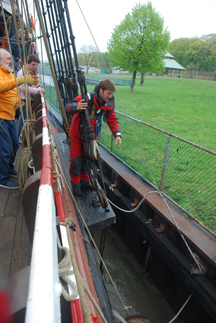
In addition to our daily log, we've answered some e-mail questions from those of you following at home. Click here to jump directly to the Mail Bag.
0730 hours
Current Position: Moored at Yonkers, NY.
Latitude: 40˚ 56.76'
Longitude: 073˚ 54.1'
Day Three of our Voyage of Discovery.
We've allowed ourselves a leisurely start to the morning, enjoying breakfast after we rise.
0930 hours
The tide is turning, so the time has come for us to move on. We loose our mooring lines and pull away from Yonkers, making our way north.
|
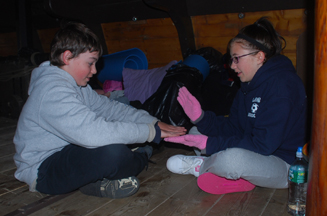
1030 hours
The weather is still cold, blustery, and damp, though it could be worse -- the expected rain came through during the night, and the skies are predicted to clear around midday. In this sort of weather, the off-duty crew tends to congregate below decks, passing their free time by socializing and playing games.
|
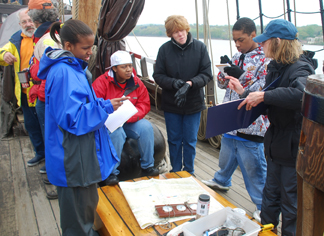
Meanwhile, on the weather deck, orientation continues for the students' research projects.
|
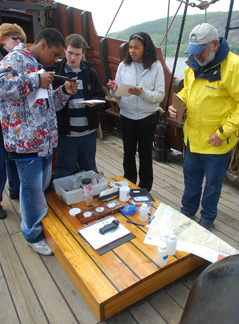
1130 hours
In this damp weather, it seems only natural to test the relative humidity. Beniah, Jesse, Kristie and other students learn how to use the sling psychrometer.
|
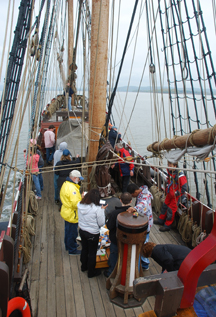
The skies remain gray as we motor north through Haverstraw Bay, but spirits remain high.
|
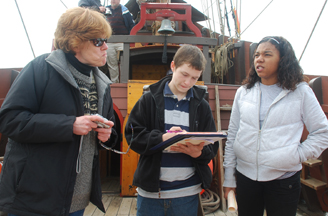
1145 hours
As we continue upriver, the students keep a scientific log of various environmental conditions, entering their readings into notebooks.
|
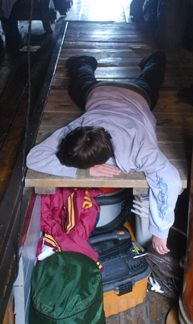
1215 hours
Some days, the wait for lunch can seem long indeed...
|
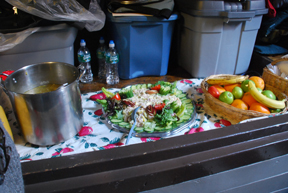 |
Mouse over to admire the Huzaren salade. |
...especially when you know it's going to come up from the galley looking like this. Along with chicken noodle soup, Mr. Gorter has presented us with a traditional Dutch entree called Huzaren salade, a sort of potato salad that includes ham, pickles, apples, onions, and more.
|
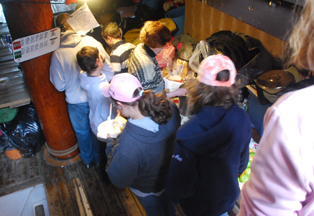
A line of eager crew members quickly forms and devours Mr. Gorter's artistry.
|
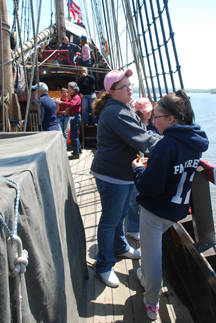
1300 hours
Could it be? Are there shadows in that photo? Yes, indeed! As we had hoped, the clouds are breaking up and the sun has emerged. Over the next hour, the crew members will gradually peel off the extra layers of coats and sweatshirts which have cloaked them since their arrival.
|
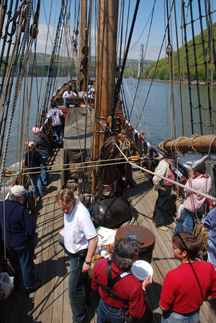
1315 hours
By the time we pass Peekskill and come into view of the Bear Mountain Bridge, the weather has turned warm, sunny, and perfectly pleasant. Blustery winds are still blowing, which would be wonderful, except that they're still blowing in from the north.
However, in a few hours we'll reach our anchorage in a wide section of river informally known as Newburgh Bay. Once there, we hope to have time to turn around and sail back south for a time before swinging around once more to reach our destination.
|
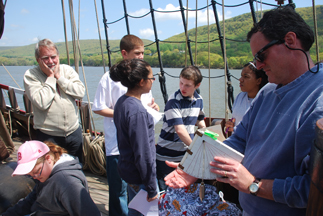
Beyond Bear Mountain Bridge, we enter the Hudson Highlands. With the sun beaming down on us, Mr. Linehan can also finally introduce the students to the quadrant and the concepts of celestial navigation.
|
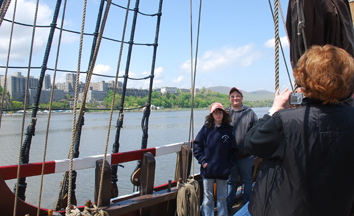 |
Mouse over and say "cheese." |
1400 hours
Mrs. Mahigian lines up her Rensselaer students Mary and Casey for a snapshot as we pass West Point.
|
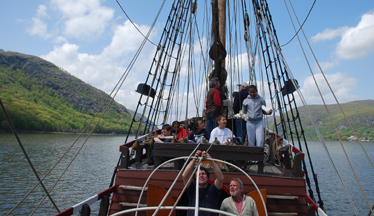
1415 hours
With the favorable weather unchanged, we reach the northern end of the Hudson Highlands, marked by Pallopel Island. Once we reach the Newburgh-Beacon Bridge we'll swing around and sail back to this spot. |
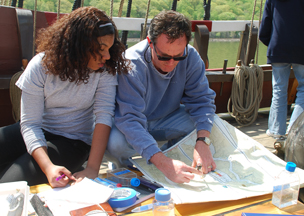
As we motor north through the bay, Mr. Linehan supervises as Kristie records a temperature reading for her project.
|
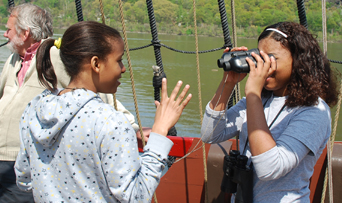
1430 hours
With her work done for the moment, Kristie has time to goof around with friends. Jasmine seems so distant lately...
|
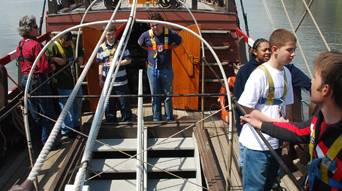
As we near the bridge, we need to start preparing the sails. Mr. Moore, Mark Morel, and Mr. Schuijer recruit a team of eager students to help work in the rig.
|
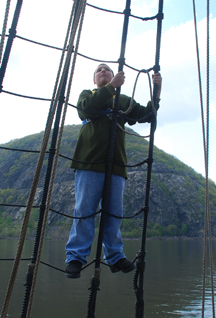
Many of the students have been itching to climb to the top of the masts, and their first opportunity has finally come.
|
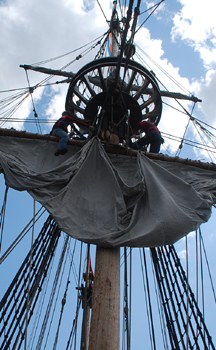
1445 hours
The climbers' first task is to unfurl the sails, which means removing the protective gaskets (lines used to tightly bind the sail). This frees the sails for use. |
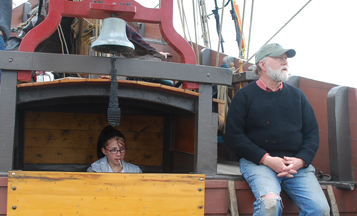
1515 hours
Sienna is at the helm, under mate Hansen's command, as we come into position to set sail.
|
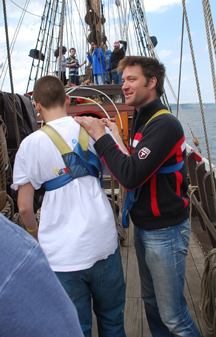
Mr. Schuijer offers Muhammad a congratulatory pat on the back after they return to the deck upon successfully unfurling the main mast sails. |
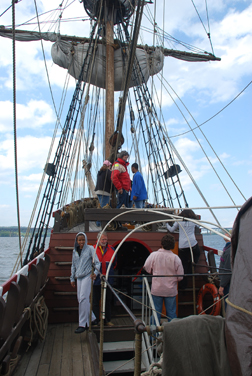
1530 hours
We call all hands on deck and divide the students into two sail handling teams; one to work the fore mast, and one to work the main.
As we peel away from Newburgh-Beacon Bridge, we set the sails and shut off the engine. Mr. Schuijer acts as main mast captain, while Mark Morel takes the position of fore mast captain.
|
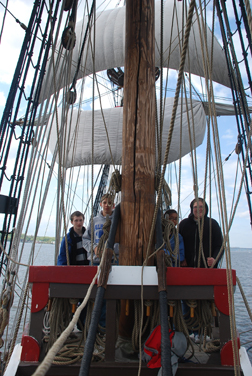
1630 hours
For the next hour we glide southward back downriver, enjoying the calm.
While we sail, Mr. Linehan engages in a little research project of his own, just for fun. Using lines of position, he attempts to track our position each time we change course.
|
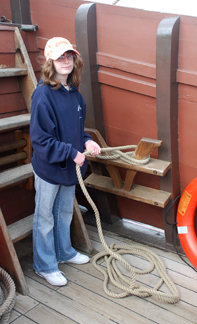
1645 hours
This is a training session, so we brace and reset the sails several times. The students move from one line to the next on their mast, learning the ropes. Here, Mary is manning a port sheet, which pulls the corner of the main course back toward the stern of the ship.
|
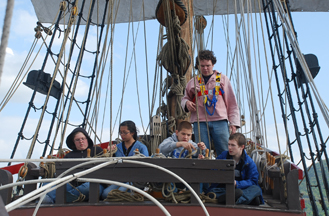
The foremast crew hunkers down for safety and comfort as they practice bracing the fore course.
|
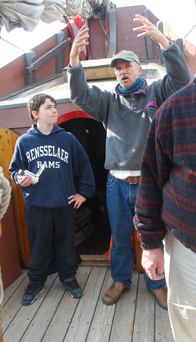 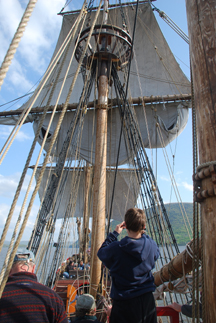
The Rensselaer students have brought a video camera with them, with Jacob as their skilled videographer. Captain Reynolds gives Jacob some directorial tips on how best to capture the sails on screen.
|
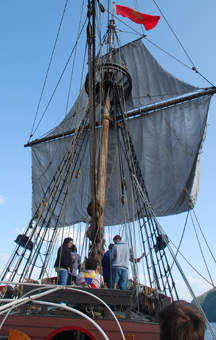 |
Mouse over to douse the fore course. |
1700 hours
As we once again close in on Pallopel Island and the Hudson Highlands, we're running out of space and out of wind. Sadly, the time's come to douse our sails, turn the engine back on, and reverse course.
|
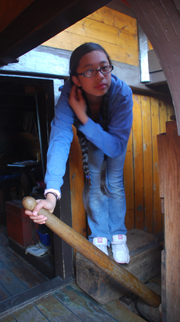
1730 hours
Thwe-Thwe is at the helm as we once again close in on the Newburgh-Beacon Bridge. We'll be anchoring just south of the bridge tonight.
|
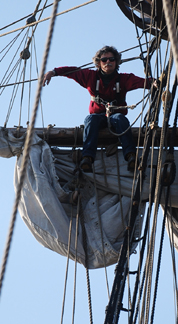
1745 hours
Now that we're done sailing for the day, we need to furl the sails. Mr. Moore eagerly hops up the fore mast and waits for his climbers to join him.
|
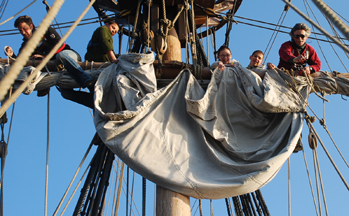
1845 hours
Once the fore mast is done, everyone focuses on furling the heavy main course.
|
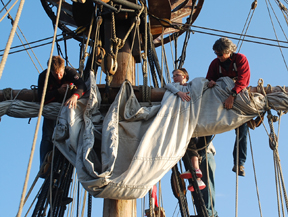 |
Mouse over to furl the main course. |
By repeatedly folding the sail into itself, and then tightly lashing it to the yard arm with gaskets, we protect the sail from being damaged by high winds.
|
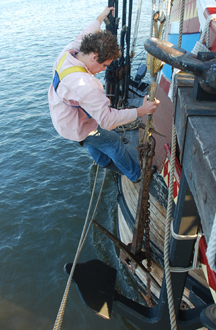 |
Mouse over for a close look at the fid. |
1900 hours
Down on deck, we're approach our anchorage for the night. Mark Morel climbs down onto the starboard fore channel to control the anchor as the fore deck team lowers it to the water line. Once the anchor is in position and Captain Reynolds gives the command, Mr. Morel yanks out the fid -- a wooden wedge sometimes nicknamed "the carrot" -- and the anchor plunges to the bottom.
As a note, the large, black anchor pictured here closely resembles the historical anchors the original Half Moon would have carried, but it's actually just for show. The real anchor is the one dangling below Mr. Morel.
|
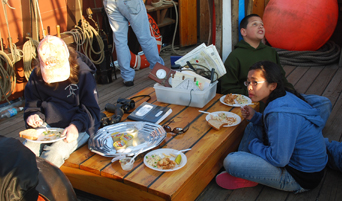
As soon as the anchor is down and the ship is secure, dinner is served on the orlop deck. The crew finally gets the opportunity to sit and eat in the comfort of a sunny weather deck. Tonight's meal is chicken sate, which is served with a thick peanut sauce. It's a massive hit with the crew, as you'll see in the Mail Bag, below.
|
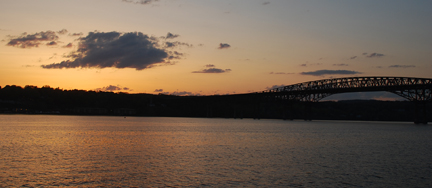
2000 hours
As we clean up after dinner, the sun sets behind the hills of Newburgh.
|
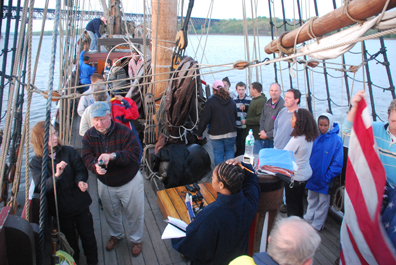
2015 hours
Before we lose our remaining daylight, Daniella and Jacob summon the entire crew to the weather deck to help with their research project, which is based on lines of position.
|
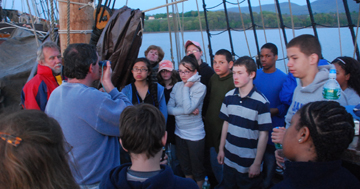
Unfortunately, this experiment requires that we remain in a fixed location, and just as we're about to start, the tide changes, pushing the Half Moon into a wide, slow 180˚ turn that could take as long as an hour to complete. By then it'll be completely dark out, so Jacob and Danielle are forced to delay their project until tomorrow.
|
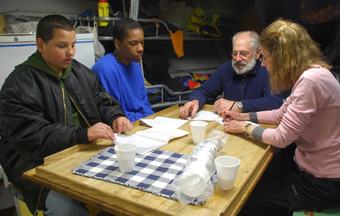
2045 hours
Speaking of tomorrow, the orientation phase of the students' projects is winding to a close. Tomorrow brings a push to begin collecting data. Keith and Beniah are studying solar energy and charting the sun's movement across the sky, so they'll have to get started first thing tomorrow morning. Tonight, they sit down in the galley with Mr. van Aken and Dr. Jacobs to work out their ideal procedures.
|
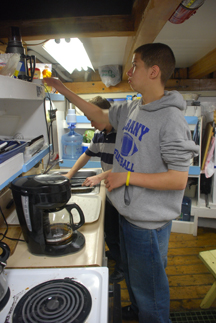
Meanwhile, Jacob and Muhammad are also hanging out in the galley -- they've volunteered to help clean dishes.
2100 hours
Captain Reynolds informs the students that we've recieved some e-mail questions for them, and they're asked to include some answers in their journal entry session tonight. See the Mail Bag immediately below for more.
2200 hours
Lights out and anchor watch begins. We pass the night quietly under the open sky. Tomorrow brings a long day of travel and the push to collect data for the student projects. |
 |
We’re always happy to hear from friends and family of the Half Moon and its crew during our Voyages of Discovery. Today we received two questions for our students via e-mail. After dinner, we held a “mailbag” session and asked the students to provide us with their opinions.
If you’d like to write the crew, just click here to e-mail us on board. We’ll respond as opportunity allows.
Q: Your cook’s name makes him sound Dutch. Is he Dutch? Is his food different than American food? Does it taste good? What have you eaten?
—From Nora M.
There’s a funny story here, but first some answers concerning Dutch food:
A: It has a lot more peanut butter. We have had things such as chicken noodle soup and chicken with peanut butter on it. The food is delicious.
|
| |
A: One of the meals he made was chicken covered in peanut butter. Yes, I like the food.
|
| |
A: I’ve eaten everything from hot dogs to peanut butter covered chicken. I love the food.
|
The irony is that as we’ve come to know the Netherlands’ culture over the years through our visiting Dutch crew members, we’ve observed that, in fact, the Dutch eat far less peanut butter than we Americans tend to do. The real story here is that none of the students can stop raving about tonight’s chicken sate (chicken with peanut sauce) dinner; obviously it went over like gangbusters. All of the students agree that Mr. Gorter’s food is delicious (even the ones who like his hot dogs best).
Q: Was it fun working in the rig? How about furling and unfurling the sails? Do you have to do anything special before climbing the rig? Do you watch the stars at night?
—From Anonymous in Selkirk
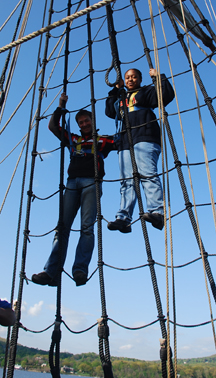
We’ll let Daniella tackle this one:
A: Yes, it was really fun working in the rig. I didn’t go that high because I was too scared. When we furled the sails we had to “slack” the bunt, martinet, and clew ropes and pull on them, and then we had to tie the ropes back to the pin and coil the rope. But when we unfurled the sails we let the rope go and tie it up again.
Yes, we do have to do special things before we climb the rig. First you need a harness, but when you’re about to climb you always have to have one hand on the rig and the other on the hook of the harness.
No, I haven’t looked at the stars because for the past couple of days we had rain and fog with high winds. So there really haven’t been any stars to look at.
|
(Editor’s Note: With the weather clearing today, the crew will get their first chance to see the stars tonight. Also, Muhammad adds that although we couldn’t see the stars while anchored in New York Harbor, we could see the beacon of the Statue of Liberty.)
|
| |
|
|
|










































